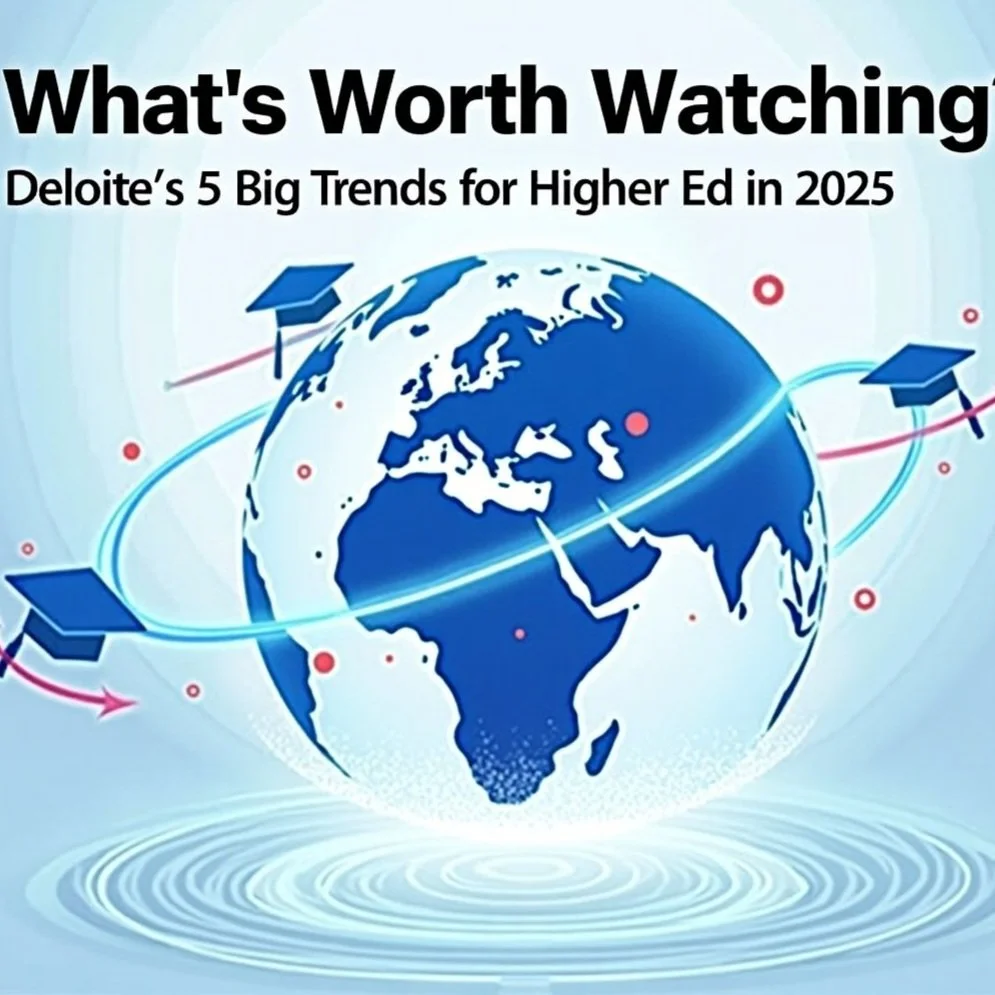What’s Worth Watching? Deloitte’s 5 Big Trends for Higher Ed in 2025
by Claire Brady, EdD
“Deloitte’s report isn’t a blueprint—but it is a provocation. A reminder that our sector is under both scrutiny and strain, but also uniquely positioned to shape the future of work, civic life, and human development.”
As campus leaders, we have deep expertise in our students, our communities, and the histories that shape our institutions. But that doesn’t mean we can afford to ignore the view from 30,000 feet. Deloitte’s recent report, Trends: A Look at the Challenges and Opportunities Shaping America’s Higher Education Sector, offers a bird’s-eye perspective on the forces reshaping the higher ed landscape. While not every recommendation may hit home for every campus, the five trends Deloitte outlines are worth serious reflection—especially as we plan for institutional resilience and reinvention.
Trend 1: Tackling Significant Financial Headwinds
It’s no surprise that financial strain tops the list. Between rising overhead, declining enrollments, and increasing political scrutiny over how dollars are spent, institutions are being asked to do more with less—and faster than ever. But Deloitte’s message isn’t just about belt-tightening; it’s about intentionality. Strategic budgeting, they argue, must align spending with mission and student outcomes, not inertia.
This means confronting hard questions: Which programs drive impact? What services are essential, and which have outlived their relevance? As one participant in Deloitte’s New Era Forum put it, “If institutions keep operating this close to the margins, there is no room for error, no room for creativity.” Transparent, mission-aligned budgeting is not just good practice—it’s a trust-building tool that invites faculty, staff, students, and stakeholders into problem-solving.
Trend 2: A New Risk Paradigm for a Complex World
Risk management in higher education used to focus on buildings, budgets, and compliance. Today, it must also encompass data security, reputational risk, free speech, DEI, AI policy, and more. Deloitte encourages institutions to move from reactive to proactive risk frameworks by adopting enterprise risk management (ERM) systems that cut across all functions and embed shared responsibility.
The DePaul University example is compelling: they’ve integrated ERM into leadership structures and strategic planning, enabling a more agile and aligned approach. In today’s climate, every senior leader must be a risk manager—and that includes anticipating how AI, climate events, public scrutiny, and social unrest may impact the institution. Risk is no longer a side conversation for legal affairs; it belongs at the boardroom table.
Trend 3: Reimagining the Four-Year Degree
Perhaps the most urgent and public-facing trend Deloitte explores is the shifting perception of the four-year degree. With only 22% of Americans believing a bachelor’s degree is “worth it” when student loans are factored in, the traditional 120-credit model is under pressure from all sides.
This isn’t about abandoning degrees—it’s about rethinking how we design and deliver them. Institutions are piloting shorter pathways, stackable credentials, embedded microcredentials, and competency-based programs. States like Indiana and Utah are mandating “degree-in-three” models. The University of Texas System is embedding industry credentials into bachelor’s programs. These are not marginal efforts—they are redefinitions of value.
For institutions clinging to tradition, the risk is irrelevance. For those embracing flexibility, workforce alignment, and clearer learning outcomes, the opportunity is immense. Faculty must be at the center of these redesigns, ensuring rigor, relevance, and responsiveness to students’ needs and employers’ expectations.
Trend 4: Evolving Workforce and Leadership Models
From interim presidencies to NIL contract negotiators, the workforce of higher education is shifting dramatically. Deloitte highlights the high turnover in senior leadership, especially CAOs and CHROs, and the increasing use of multiyear interim presidents to fill the gaps. Meanwhile, AI is reshaping the roles of staff and faculty alike, prompting institutions to rethink structures, skill sets, and succession plans.
One of the most actionable ideas here is upskilling: investing in our people to adapt to new tools, new roles, and new challenges. As Deloitte notes, institutions that use AI strategically—both to streamline operations and enhance learning—will need to ensure their staff and faculty are prepared, not sidelined. And that takes leadership with vision and follow-through.
Trend 5: Embracing “Systemness”
The final trend is both pragmatic and aspirational: systemness. More than mergers or shared services, systemness is about thinking collectively—leveraging the scale of networks, reducing duplication, and expanding opportunity through collaboration. The CSU system’s Multi-University Collaboration Initiative and cross-registration efforts among state systems are two promising models.
At a time when even flagship institutions are feeling financial pressure, systemness offers a path toward efficiency without sacrificing mission. But it’s not easy. Successful systemness demands shared vision, coordinated action, and strong leadership across institutions. It also requires honest conversations about identity, autonomy, and student-centered impact.
A Call to Action for Higher Ed Leaders
Deloitte’s report isn’t a blueprint—but it is a provocation. A reminder that our sector is under both scrutiny and strain, but also uniquely positioned to shape the future of work, civic life, and human development.
We don’t need outsiders to tell us how to run our campuses—but it helps to have a national mirror that reflects back the forces shaping us all. By taking these five trends seriously, and responding in ways that are tailored, transparent, and transformational, we can lead with clarity and confidence into the next era of higher education.
Let’s not waste the urgency of this moment.
Read the full Deloitte report: https://www.deloitte.com/us/en/insights/industry/articles-on-higher-education/2025-us-higher-education-trends.html?utm_medium=DSMN8&utm_source=LinkedIn

